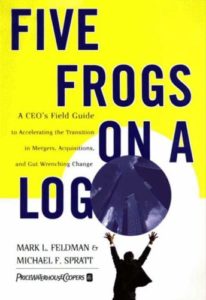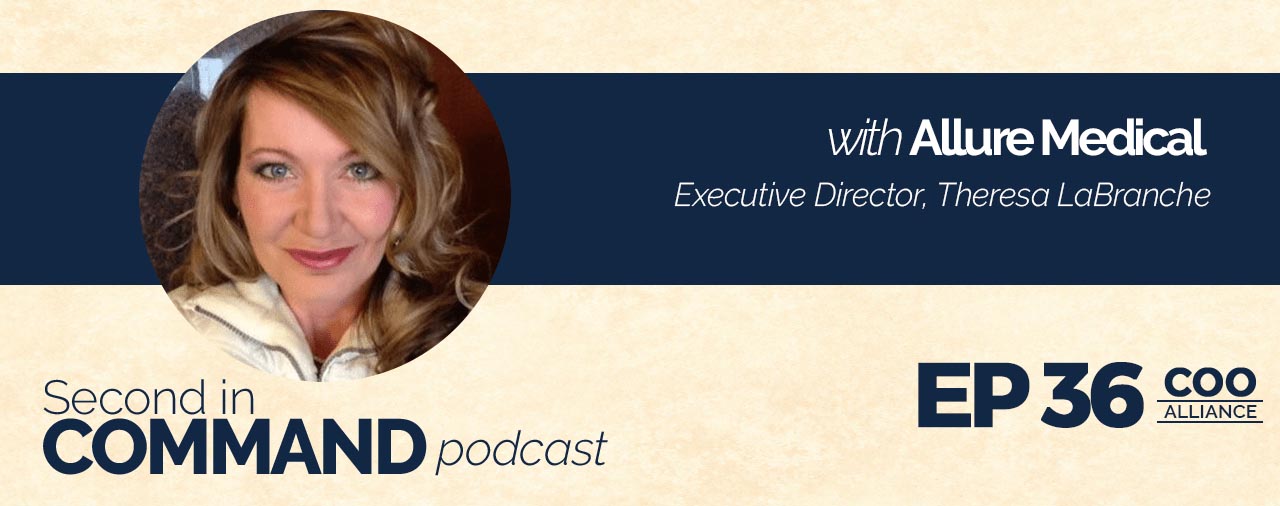Resources:
Connect with Cameron: Website | LinkedIn
Get Cameron’s latest book: The Second in Command – Unleash the Power of Your COO
Subscribe to our YouTube channel – Second in Command Podcast on YouTube
Get Cameron’s online course – Invest In Your Leaders
Allure Medical Executive Director, Theresa LaBranche
Theresa LaBranche is the Executive Director and a certified physician assistant at Allure Medical. She’s also the second-in-command. Allure Medical is an innovative medical spa that uses world-renowned treatments to achieve its mission of helping their clientele not only look their best but feel their best. Theresa has been with the company for over ten years and has been instrumental in doubling their revenue in one year, reaching over $40 million, doubling locations and growing to over 200 employees. Theresa broke the family mold by being a woman and going to college against her father’s wishes. She obtained a Master’s of Science and a physician assistant licensed by age 26. Along with lots of self-study in business and operations, she’s also a grateful leader, specializing in employee engagement in logistics. She believes firmly in growing your business by growing your people and always seeks to harness the unique abilities of our workforce. She’s also one of the founding members of the COO Alliance. Theresa, thanks for being on the show.
Thank you for having me, Cameron. It’s always a pleasure to speak with you.
I’m looking forward to this. It will be fun. Tell me a little bit about your journey with Allure Medical. How you got started and also give us a real quick rundown on what the company does. How did you get involved in the company and how do you think you got to where you are in the organization now?
It’s an interesting story. When I joined the company, I capitalized on serendipity and more or less fell into the position. I was standing in the Post Office and I looked over a patron’s shoulder in front of me and I saw the Allure Medical’s return address on the envelope. I was new to the area so I had asked the patron, “I didn’t realize there was a medical facility in that building.” I told her that I was a physician assistant and I was scoping out the opportunities in the area. I wish to work closer to home. She said, “In fact, we are looking for a physician assistant.” I said, “I’m not a medical assistant but a physician assistant.” She said, “Yes, a physician assistant.” She said, “Dr. Mok, the Founder, is looking for some extra help.”
I said, “I know Dr. Mok because I had referred patients to him when he was the Vice President of the emergency room at a local hospital. We had a conversation where he and I had a little conflicting opinion of what the care of the patient should be.” He remembered who I was. I had worried that perhaps that would go against my chances for being part of his company but I think he respected that I was able to articulate my wishes for my patient who I care deeply about. I went in and for several walk-in interviews and after six months of pestering, he hired me. At that time, I was working as a physician assistant and learn vein procedures and vein practice. He was growing the cosmetic practice at that time and he invited me to become the cosmetic director. I said, “What does that mean? What do you want me to do?” He said, “You’re already doing it. All the employees are already following you. Just have meetings and things.”

Business Growth: Measure and get feedback from the consumer and then adapt to the actual needs.
I started researching, “What does this mean? How do I become a director?” We were successful. We ended up growing the cosmetic business to $6 million over the next eight years. At that time, the rest of the practice was booming. We still had one location and we expanded to a second location at which time I became the Clinical Director overseeing all the medical practice. From there, I kept learning and learning and my level of learning is my success and the wide-open opportunities. We started training ourselves in business. Dr. Mok and I transitioned out of patient care a few years ago and at that time is when we became wildly successful. We started expanding out of state. We now have thirteen locations, seven within Michigan and six outside of Michigan. I was promoted to the executive director by default I guess because I knew the business as well as anyone else.
I love what you said that he said just do meetings and things. Your CEO is a classic entrepreneur, probably execute now, plan later. How do you stay in alignment with his vision? He definitely wants to grow quickly. I understand you guys bought your first company jet and you’re buying a second to keep up with your growth now because you’ve got so many people traveling so quickly all over the place. How do you stay in line with his vision and how do you keep him aligned with the plans that you want to put in place to grow the business?
That’s been a unique position of mine because I do have a medical background. I understand his language and my Kolbe score is similar to his in some regards so that I’m able to envision like he is or I can clearly see his vision. Where I differ from him is that I’m able to translate that vision into a strategic plan and I’m able to communicate that to the employees. He is able to communicate the vision but then I follow up and communicate how we will get to that vision. I do have to have constant interaction with him being his entrepreneurial nature and his quick start. He changes plans quickly, so regular interaction with him is necessary for me to be able to carry out his visions as they change and as they develop. We believe in the Scrum method where you roll out the minimum viable product. Then you measure the results you adapt and you continue doing that throughout time after execution for the maximum benefit.
You use the Scrum method in all parts of the business as well, don’t you?
Correct, when we roll out new service lines or new strategic delivery methods. We normally run a little pilot of one of the offices or a small sector of the market and then we measure. We get the feedback from the consumer and then adapt to the actual needs.
It’s interesting, the term MVP came out years ago as a Minimum Viable Product. I started talking about it, even coining the phrase MVE, which is Minimum Viable Everything. The reality is at the end of the day, no one needs perfect. They need something that’s out the door that’s good and momentum drives momentum. You guys are good in the momentum driving momentum. Touch quickly on the regular interactions that you have then with Dr. Mok. How do you stay in touch when he’s traveling so much and you’re on the road a lot with all the acquisitions you are doing and new openings? How do you stay on the same page with him specifically?
I had taken your advice, Cameron. I initiated the 15/5 where I can write down fifteen minutes of information I think he may not be aware of like the operational or initiatives that are going on. At the same time, it takes him five minutes to read that and then he can reflect and email or phone me so we can always be on the same page. We do have a weekly meeting and no matter where the strategic council is, we zoom in. We’re getting more and more adept at handling remote employees and remote meetings. No one has to be necessarily physically present any longer. We got pretty good at communicating remotely.
I love that you’re using the 15/5 report as well. Just to recap on that, it takes you fifteen minutes to write out a one-page or two-page report and you type it all out for him and then it only takes him five minutes to read it. The cool thing about that system 15/5 is that you often write stuff down that you maybe wouldn’t say face-to-face normally. Because you’re now meeting with them face-to-face or talking over video, you’re reading everything you already typed up and it starts to come out. It allows the employee to express everything. Do you use that tool with any of your direct reports at all yet?
I do and what I’ve found is that when we do communicate in this manner, often when someone reads this, they’ve done it at a time during the day when they’re able to focus and they’re not interrupted. Frequently, when you’re in physical meetings, you may have someone knocking on the door with an urgent need. When people go through their email or sit down at the end of the day to recap, they have time to focus and reflect more accurately and give some serious thought to what is on that page and what they need to relay back.
Now that you’re using the paper-based system, I always tried to get people to start with paper and then automate it later. Take a look at a company called 15Five.com. It was started by a CEO in the Bay Area, David Hassell. They have created an entire software package around the 15/5 process. It can allow you to scale this out as you are opening up and all your needs to this too. He’s done a good job with it. You started being plucked out of the postal lineup and started when the company has about 40 employees and there are 200 now. You have five times the number of employees. Then the revenue was around $2 million and you’re about $40 million now. You have 20x your revenue and we’re just getting started here. How have you specifically grown your skills? What have you done over the years and maybe walk us through a timeline of the last few years? How have you stayed relevant? How do you continue to grow your skill set as the second-in-command?

Business Growth: We can train employees with the skills that they need so long as they have the cultural fit and that incessant thirst.
I read incessantly probably every two days. I’m obsessive about reading business books. One of my sixteen-year-old son’s friend was in the kitchen and my den is off of the kitchen. The den is littered with books, stacks and rows. He said, “Mrs. LaBranche, do you get bored of reading?” I said, “Never, I have a level of learning and beyond the books then you can pluck out the relevant information.” We’ve also been members of Verne Harnish’s Scale Up for Gazelles pro. The Scaling Up book has been instrumental in our growth and we’ve used many of the tools in there. We’ve had coaches over the last few years for the strategic council, which has then fairly malleable and changing. It’s like an amoeba, every year and now almost every six months, we have to change the numbers because as the company grows, you need to bring in new knowledge.
I’ve tried to align myself with people who are smarter than myself in different areas and complement my weaknesses per se or lack of knowledge with people who are strong in that. Then I can go ahead with what I’m strong in and reciprocate the knowledge. I’m also completing the Master’s of Business Dynamics course through the ScaleUp Institute. I’ve also enrolled in an MBA program to further my knowledge. I noticed some of the Millennials had some computer skills that I didn’t have. My IT department tutors me regularly and I’m now all cloud-based. No matter where I am in the world, I can access all of my documents and share them. It’s been a continual process from multiple sources to continue to grow.
I think you touched on or nailed exactly what it is. You have a thirst and a hunger for learning and you want to continue to grow. I’m not sure if you were at this event. You were one of the founding members of the COO Alliance, which is the only network of its kind in the world for people like us, the second-in-command. At the event I was talking about we need to hire people and work on the training of our team and always growing our team. I said, “A leader’s job is to grow people.” One of the members in the room said, “Why don’t we focus on hiring great people who love to grow on their own?” I was like, “That’s awesome.” It hadn’t even occurred to me that that should be one of the five core behavioral traits that we look for in all leaders. It’s someone like you who has that thirst for learning. It’s like Herb Kelleher from Southwest Airlines. They asked him, “How do you get all your employees to smile like that?” He said, “We hire smiling people.” “How do you get all your employees to learn and to grow?” “We hire people that like to learn and grow.” I think you actually are that perfect type.
When we do culture screenings for our employees, it’s criteria that they’re internally motivated and that they have a hunger for learning.
I would keep that for sure as part of the core on your leadership team and explain to your team why we look for that because it will go over on some people’s heads. They won’t recognize how important that is. We tend to go back to looking at the specific skill set versus the actual behavioral traits of the person.
The culture of screening is so important that we started to take employees who only fit the culture and don’t necessarily have a skill set that matches the job description. We can train them with the skills that they need so long as they have the cultural fit and that incessant thirst.
The real growth is going to come from hiring the skill set and culture. We used to say hire for attitude, train for skill, which is what you were touching on. I want to hire for the attitude and the proven skill set and that’s where real accelerated growth comes from. I bumped into a guy, Laurie Baggio, who we brought on in the very early stages at 1-800-GOT-JUNK?. We brought him in to grow our franchise development group to franchise sales. Laurie had already been a proven entrepreneur. He had been in the technology space and came in huge culture fit right away but he already knew how to run this business. He knew how to build out the division and he knew how to do the sales group. It’s not like we had to give him any skills. He came in and hit the ground running so quickly, we had to keep up. He built out the team that accelerated the growth of the organization.
That is where we’re at. We’ve started to hire people with skill sets larger than we need because we will need that skill set within six months. Hire bigger than you need if you can be ahead of the curve as long as you can afford it and be wildly profitable. You can buy the knowledge that you need.
“There’s not a single problem that exists that a check can’t solve.” I think that was Dan Kennedy who said that. You said something and I’m going to come back to it right now. I don’t even know if it dawned on you when you said it. I’ve known you now through the COO Alliance and through some coaching over the years. You often talk about the fact that you’re the only person who says no to the CEO and there to Dr. Mok. When you keep saying no, you often feel like you’re that conflicting opinion to him.
You said right at the very beginning that when you first met him, even before he hired you, you had a bit of a conflicting opinion with something. You said maybe he respected that in you. You need to internalize that and know that he actually respects that in you. He probably spends most of his life where people don’t say what they think and they’re looking up to him and admiring him and trying to figure him out. You’re the only one or one of the only rare people who’s ever said, “No, that doesn’t work or no, I disagree, or no, I think you’re wrong.” That conflicting opinion might be one of the core reasons why you are where you are.

Business Growth: The Love Language Test is effective in understanding what a person needs to feel valued.
I’ve taught that to my teams that quick starts inherently when they get a processor or a fact finder who needs more information, they take that as an opposition to their idea. I’ve now taught them to pre-suade the situation so that if they’re speaking to a visionary or someone who has a new idea to say something similar to, “I liked that idea. I think it might work. I have a few more questions this time to ask.” It lowers the guard of the person with the idea so they know you’re not questioning their idea. You just want a little more information.
I adopted the three-day rule early in my career here where if he came with an idea, I would support the idea. I wouldn’t ask many questions and after three days past, then I would re-approach the situation and I would recap and make sure I had a clear understanding of his vision. By then usually, it had morphed a tiny bit because he was saying the vision to get some feedback and develop it a little more and mulling it around. That was very effective. At that time, after the three days, I could see now it’s time to make the implementation strategy and the execution strategy. Before that, just let it morph a little.
I love what you’re saying about the pre-suasion part when you walk in and say, “I love your idea. I just have a couple more questions before we can run with it.” I don’t know what the movie is but it was like, “You had me at hello,” for a quick start. That’s our love language. That would be any quick start’s love language to say, “I love your idea. Let me ask you questions because we were still thinking out loud.” For anyone reading this, if you haven’t done a Kolbe profile, I suggest you do it and have your CEO or your team do them as well. It tells you how you start projects. A quick start is someone who starts them quickly and then plans later.
Often we’re accused of shooting from the hip or making it up as we go or winging it. Someone who has a very high first number is called the fact finder and they ask a lot of questions before they start something. The Kolbe is a four-number profile. The second number is called follow through and that’s a person who puts systems in place before they start something. Then the last one is implementer and that’s someone who needs the tools or a model in place before they can start. It’s important to understand with your team and yourself how you like to start things. It’s cool that you guys are doing those. Have you done any other personality profiles with your team?
Yeah, we sure have. We prescreen all of our employees before they onboard with the Kolbe so that we know how do they take information fast? How can they learn the most quickly? What do they need to be successful and how their training is presented to them? Additionally, we use the Predictable Success model and identify who’s an integrator, who’s the visionary and complement the Kolbe with that. For my direct reports, I have had them take the love language test. I know that sounds crazy but, Cameron, you recommended it to me and it was so effective in understanding the difference of what a person needs to feel valued. It was enlightening to me. I instructed my direct reports, “Take this with your work in mind, not your spouse or lover per se because it would change the answers.” To my surprise, some of my direct reports actually had physical affection ranking in the top three. I never even considered the fact that someone may just need a hug.
I don’t know the model well-enough to say whether we have to steer them to say, “Think of your work people versus your intimate relationships,” because my love languages, and I only thought of the intimate relationships, are physical touch and words of affirmation. They’re tied as my top two way above any of the other three. The other three are acts of service, gifts and quality time. Mine are physical touch and words of affirmation. For me, I don’t need somebody giving me a massage at work but a hug is awesome or a pat on the back or somebody who comes up and sits down with me and taps me on the shoulder. It somehow grounds me and reconnects me. I think it’s powerful. I encountered another one that came out from the love language group and it’s called the apology languages.
It’s how we like to be apologized to. After we’ve been hurt or feel wronged, how do we like to apologize and how do we like to be apologized to. That was interesting as well. I have a need, if I do something wrong, I feel bad about it. Regardless, I feel very empathetic about the person that I’ve hurt or wronged in virtually every situation. I don’t need an acceptance of my apology. I don’t need them to say it’s okay. I don’t need forgiveness. I need to be heard. I need them to hear that I’m sorry. If they accept it, that’s okay. For me, if I hurt someone, all I need is to then say, “I’m sorry,” and have them hear it. Other people need to be forgiven. I’m starting to dig into that model now called the apology languages.
We embrace not dissecting a mistake and we don’t place blame when something happens that has a bad outcome. We simply look at the situation and try to learn from it. That being said, it’s crucial that people understand when to say sorry and take accountability when something didn’t go right. I think that would be a great tool. Thank you for that.
It’s going to be an interesting one. I want to touch on something and this is huge. You have gone through and give us the growth may be in the last few years. How many locations did you have a few years ago?
We had four.

Business Growth: Eventually, if you’re successful, the growth of the company will exceed the growth of a person’s growth.
Now you’re at thirteen. You’ll be at how many by the end of next year?
If the plan goes as planned, we should be at 30.
In three years, you are going to go from 4 to 30 locations, which is under 800% growth. That’s around 750% growth in locations. How many employees did you have at the end of a few years ago?
About 100.
How many do you have now?
About 240.
Then next year?
It will be doubled or more.
You’ll be at around 450 by next year. You’re going to have gone from 120 to 450 people in three years. Your company will be 350% bigger on the employee count. Then what was your revenue a few years ago?
It was less than $20 million.
This year it’s $40 million and next year?
It should be well-over $80 million to $100 million.
From $20 million to around $80 million to $100 million, so 400% to 500% growth. That’s massive growth. I was talking with Clate Mask who was the Founder of Infusionsoft and we were at an event together called The Genius Network. We were talking and he said that a senior executive can only go through two consecutive doubles in their role without the company being so completely different that they’re often at risk in their role. Meaning a company can only go from $4 million to $16 million and by the time you get to $16 million, it’s hard for that senior executives to stay in their role to go to the $32 million. I was reading Ben Horowitz’s book called The Hard Thing About Hard Things. He said that a senior executive can only go through one triple, which should be from $4 million to about $12 million.
The data points are very similar. My corollary to that would be that if you come into a company with a lot more experienced than the role demands as I walked into 1-800-GOT-JUNK? and it was a very small company and I had already built two big franchise companies. It was way beneath what I needed for skill set. For the first couple of years, I wasn’t that challenged and then the next couple of years, the last couple of doubles, it was challenging for me. I had to leave at the end of six doubles. We went $2 million to $106 million in six years. You’re going through that now as an executive and as a team. You talked about with me around the difference between loyalty-based leadership and results-based leadership. Walk us through what you mean by that concept and walk us through the transition that you are having to spearhead to bring in the senior team to take the company to the billion-dollar level.
This is a significant topic because anyone who’s wildly successful will eventually go through this if you were part of the founding team. I had fallen into my position more or less because of loyalty-based leadership. There’s a term of title inflation that occurs. For example, someone who’s the COO or CEO of a $4 million company looks massively different than someone who’s a COO or a CEO of a $40 million or $100 million or billion. As the company grows, the strategic council, which is basically our executive team has been morphing slowly. We’ve been able to bring in a few people here or there. We’ve been able to grow ourselves. Eventually if you’re successful, the growth of the company will exceed the growth of a person. You have to be able to have enough internal awareness to recognize when that occurs.
You have to realize when you’re the smartest person in the room, that’s a precarious situation. You have to go through what I call an identity shift where you recognize this is occurring. Coming to terms with your own personal identity is not synonymous with your job. If you’re used to changing hats frequently due to impressive growth, the transition is easier. If you can recognize your own personal value separate from your actual position or your title, then you can start looking outside and buying more or less than knowledge and the talent that you need. Many people struggle and I’ve had people turn down positions because the title offered to them wasn’t the title they wanted. The title game is a bit of a fallacy if you’re going to grow. You have to be able to take on a number of different titles.

Business Growth: It’s crucial that the existing leaders endorse the new leaders and that everything is cohesive so they can be effective.
My title externally is Executive Director. I don’t use the title COO because I don’t want to have the perception of the team such that we can’t bring in more talent. I’m searching for people who have greater experience than what we need, similar to your situation, that will come in. It will feel like the back of their hand for a period of time. At that point, we can bring in more people who have greater experience. As long as you are super focused on culture and on your people and how you care for your people, it’s easy to transition them through, “You’re part of the team right now but you’re not going to be part of the team later.” They can come to grips to it if you focus on their value and focus on their needs, which is the primary reason I started doing the love language tests. I need to know how these people want to feel valued and how to let them maintain their pride and their value and not feel slighted that they need to be in a little different position because the company is so big.
This is like Dalai Lama. You’re speaking in business concepts or business understanding at a level like the Dalai Lama speaks about wisdom in life. I don’t know if people are truly tapped into how much you get this transition you’re undertaking for the entire company. You’re hiring the team that will go above virtually everyone in the company now. You’re going to be hiring CFO, COO, Chief Marketing Officer and having to make all of those chess moves to make sure that everybody who’s there feels loved and accepted and has great roles and is even a part of the recruiting process too. You are even helping to recruit interview these senior people and then integrate them. How do you go about that? Give us some of the specific things you’re going to be doing to make sure that the next level leaders coming in get integrated into the company and get onboarded. Walk us through what you’re looking at and thinking about.
I have used pre-suasion quite a bit. I’ve been prepping the teams for the transition. I have described the transition as every department is going to get a friend. We’re going to be bringing someone who has more experience with a bigger company and they are going to mentor us. They’re going to help us learn. They’re going to help us get to where we need to be. We’ve done such a fantastic and phenomenal job that we’re now in the position where we can bring in people with more experience. By my own volition to hire a COO to be my own mentor, I took the first step because I wanted them to see how this can be done gracefully and how it doesn’t devalue me. I will always have a function in the company that I helped build. I may not be the CEO or I may not be a national COO and that’s okay because I did well. They’ve all done well. We doubled from $20 million to $40 million in one year. We’ve gotten Detroit Free Press top places to work in 2016 and 2017, Inc. 5000 fastest growing companies in 2017, Crane’s cool places to work, Detroit 2016 and 2018. I feel proud and there’s no shame in picking my own boss. At least now we have the authority and the position and the value that we can pick people who complement our team. They add to it and it’s synergistic. It’s not that you’re replaced.
Let me touch on something as well. You’re being given the opportunity and the challenge to go out and recruit and bring in your senior team and bring in the next group that’s going to take you from where you are and where you’re going to have to go. I never had that option. I grew the company from $2 million to $106 million and then I was fired. I was let go not because I’d done anything wrong. I was probably at the time a little bit of misguided by the board with Brian. Instead of Brian letting me help choose my replacement and help grow it out, he replaced me and I left. He went twelve months to find my replacement and the company struggled during that twelve-month period. Then they brought on the former President of Starbucks US to come in and replace me.
I’m sitting there going, “This is a huge business.” She comes in twelve months later and says, “What a cute little company.” It’s completely different perspectives. Amazingly interesting that she actually didn’t last. She was only there for twelve months and then she went for completely different reasons than I was. Now they’ve got a close friend of mine who I’ve known for years. He has been their chief operating officer for a couple of years. In that period, I looked at someone like Launi coming in from Starbucks and she’s really solid. I couldn’t do anything she can do. I couldn’t understand the company politics. I couldn’t understand the size of the business and the complexity of the numbers. Brian and I were being so entrepreneurial when we were $100 million company. That doesn’t work anymore.
We can’t have two very entrepreneurial leaders who are making entrepreneurial decisions and acting like cash was our oxygen and I was making mistakes. It’s amazing that you’re being given the opportunity to grow your team, which means you’re still in charge, just so you know. The person that you’re recruiting and hiring is going to always be looking at you as a leader because they’re having to impress you and sell you. You’re going to be in a very senior leadership role in that company until you decide you don’t want to be there.
I don’t know that I’ll ever decide that because I love my people. We handpicked all of them so far. I have had this conversation with the gentleman that I’m bringing in. I made it clear that one of his priorities is to mentor me and the other senior leaders. I also had the discussion with him that it would be pertinent for myself and the CEO to endorse him so that the team trust him and so that he can have influence more quickly. They’ve not had any other leaders, especially from outside. It’s crucial that the existing leaders endorse the new leaders and that everything is cohesive so they can be effective. To me, it’s important that the company succeeds.
Most of your management team and your strategic council has been with the company for five to seven years. This is a whole huge and massive shift for all of them. The new COO’s job, when they come into the organization or any new senior leader’s job when you’re hiring somebody with all the proven skills and with a strong culture and the right behavior traits. When we bring in the right person using the systems from Topgrading or who, and we know we’re bringing that right person in. I always say they’re like a big boulder and their job as a boulder is to get to the bottom of the pond and they will.
They’ve got the skills. They’ve got the right fit. They’re going to sink to the bottom of the pond perfectly like they’re supposed to. We often spend so much time trying to make sure they’re okay and to integrate them and to onboard them that we miss the ripple effects. We miss the ripples that that boulder causes and they cause good ripples and bad ripples. Thinking about that, what ripple effects are you going to be looking at, good and bad? What positive and worrisome things are you going to be looking for as a team as these new senior leaders come in?
I feel the greatest disadvantage to someone new is they don’t have the relationship knowledge that the current leaders have. There are unwritten diplomatic things that occur. There are certain people who are leading who don’t have a title of leading. People with a scarcity mindset, if they’re not coached properly, will be negatively impacted by new changes that occur. I want these new changes to occur. I want him to come in and show us, “I think this might be a better way.” We’re like, “Why didn’t we think of that?” If someone’s not coached on the front lines, they may not be so in tune to follow that lead or to understand the change they may become disengaged. Employee engagement is one of my passions. I’ll be watching to see when he doesn’t understand the relationship knowledge to be by his side and say, “You should probably know this or that,” because it’s not in any manual.
I’ve got a feeling that you’ll be doing it before as well. I’ve got a feeling you’re smart enough that you’re going to be able to pre-emptively strike and coach him and the team on all of those different issues too. I saw it happened to me. I thought I was being funny with my girlfriend’s mom and I completely pissed her off and it’s because I didn’t know her well enough. What would have worked in prior relationships or would have worked in my family didn’t work at all and caused a huge fight. It was because I completely misread the situation and misread the person. Had I been briefed more or had they been briefed more, we probably would have been able to get through it easier. I think it’s smart that you are going through that and thinking about that.
I have been teaching the teams the five-second rule that I use for myself and I’ve taught my teenage boys who are testosterone laden. When you would like to give your opinion, you count backwards from five and practice your rhythmic breathing to make sure that not the words you say but the tone, the pace and the volume that you’re using is appropriate. During those five seconds, you should do a little check mark of if there are any situations or relationships that you may not be aware of that would preclude you from speaking at all. I hope he can adapt that as well.
I’m taking that huge with my kids but also in business. That five-second rule and the way you laid it out is powerful. I’ve got a couple of final questions. One is I’d love to know what you’ve pulled out of your time in your first year because you’ve joined and renewed for your second year with the COO Alliance. What have you learned and where do you think you’ve grown in your own personal skills or what have you learned that you’ve brought back into the company? Maybe one or two big highlights from your first year in the COO Alliance?
I did not have the foresight coming into the COO Alliance of what I was in for. My CEO basically told me to join. I go, “COO Alliance? Why do you want me to go to that?” He said, “Just go.” I was like, “Okay. I don’t like to travel alone. It’s far from home.” I show up bright and shiny. I go to the reception the first evening. The very first day of my first COO Alliance, I almost cried and I’m not a crier. I realized what I had not known for all these years was how alone I was because I was leading everyone. There was no one for me to confide in. You can’t necessarily go to a CEO. Not all CEOs are coaches. They’re innovators and entrepreneurs. Being with the other COO members, I felt literally and I know it’s cliché but I found my tribe.
I felt that these people understand me. They have the same challenges as I do. I’m not so special. Anyone who’s gotten big or who have been successful goes through these transitions and these trials and tribulations. It was fascinating because your last culture event that I went to which was fantastic, Mimi, who’s a new member became a little emotional and had the same sentiments that I had. She too realizes that she is alone and we found out we lived near each other. We’re going to be able to physically go to the movies or hang out or support one another.
I didn’t even realize she lives in Troy. She’s one of the sharpest members in the COO Alliance. I was super excited when they were joining. They have had some crazy growth.

Five Frogs on a Log: A CEO’s Field Guide to Accelerating the Transition in Mergers, Acquisitions and Gut-Wrenching Change
That’s the first thing, having a tribe and support of like-minded people. The second thing that I got was a stronger network. Other people have a different experience. We often look to different industries because although we’re healthcare, we’re more similar to a retail industry and manufacturing industries. I’ve drawn from their experience. Steve is in manufacturing and they had an acquisition from Mexico. He had recommended a book to me and said, “You should read this.” I ended up reading it. It’s Five Frogs On A Log that I bought copies for the whole strategic council. He said, “Had I read that book before our major acquisition, I would have done it differently.” That networking is priceless.
That’s what I’m going to pick up. I got so much to share off. This has been cool. I didn’t anticipate having so many scribbled notes of things to share and links. Maybe because I’ve known you for so long that I take it for granted. You have a very deep understanding of what it’s like to build a company or an organization and lead it through some serious growth. I’m super impressed and I don’t say that enough to people. Have you heard of John DiJulius? He has a book called Secret Service and he runs some day spas. I think he’s based out of Cleveland. He’s part of the Gazelles network but take a look at his stuff. He has some really cool secret service ideas that you could bring into Allure Medical. I’ll give our audience an idea of one right now. Let’s say you go into a spa to get your hair done. If you go into one of John DiJulius’ spas, they have three different colored capes. I’ll make it up but they have black, white or purple.
If you’re in a black cape, it means you’re a regular customer who’s there all the time. If you’re in a white cape, it means you’re a virgin and it’s your first time in the spa. If you’re in a purple cape, you’re one of the, “Take care of this woman because she’s always getting everything done and she refers tons of people.” You can be a brand-new employee on your second day and as you’re walking down the row of women in the spa, you know that the women in purple or the one in the white are completely different from each other and the customer doesn’t know. They’ll even change up the colors of the bibs so that if you’re in there next time, you think that something is different because you’re in a black cape versus the purple cape but they changed the order on you. It’s cool to have that secret service idea in your spas. It could be something you could pull into Allure Medical for sure.
I like that. We could develop that further. Several years ago, we implemented a secret VIP denomination where a patient’s chart is flagged with the color green for big spenders. They get whisked from the lobby. That particular service line lends itself to a VIP structure.
You may have pulled that out from some of the Gazelles’ events that you go to because John DiJulius has been around the Verne’s Gazelles program for years. He’s even taught the Ritz Carlton and Disney how to do service. He’s powerful and strong in this space. The last question I want to go into is if you had one word of wisdom for emerging leaders or even current leaders in companies, something that you wish you’d known when you were 21 or 25 that you now know, what would it be? What would you leave us with?
My biggest takeaway is the sky is the limit. Make sure your dreams and your goals are so big that they scare the crap out of you. If you work hard and you’re tenacious and you have a love for learning, you’ll be surprised what can come your way. It puts you in an opportunity to capitalize on serendipity. Anytime something comes around, if you’re wide open and you’ve done your homework, it’s yours. You can have it all.
I love that you match that with your huge hunger for learning and for reading constantly and for growth as well. Theresa LaBranche, thank you for joining us. You’re the Executive Director and physician assistant at Allure Medical and the second-in-command. You’re responsible for growing and taking on the next emerging team to take you from the hundred million to the billion. Thank you so much for sharing with us.
Thank you, Cameron. It’s a joy talking to you as usual.
Important Links:
- Allure Medical
- COO Alliance
- Dr. Mok
- 15Five.com
- Scaling Up
- Infusionsoft
- The Genius Network
- The Hard Thing About Hard Things
- 1-800-GOT-JUNK?
- Five Frogs On A Log
- Secret Service
About Theresa LaBranche

Theresa LaBranche is a board-certified Physician Assistant in Surgery and Primary Care who has been practicing for over 20 years. Her extensive clinical knowledge ranges from family practice, neurology and neurosurgery to minimally invasive vascular care and advanced cosmetic rejuvenation and enhancement. Theresa holds a Master of Science in Physician Assistant from the University of Detroit Mercy and graduated cum laude from the University of Michigan with a Bachelor of Science in Biology and minors in Chemistry and Physics. She is currently pursuing a Masters of Business Dynamics. As one of the nation’s leading injectors and trainers for botox cosmetic and facial fillers, Theresa provides pan-facial restorations and youthful enhancements for her patients. She specializes in nasal and jawline reshaping, as well as lip augmentation, cheek highlighting, brow lifts, temple revolumization and even earlobe restoration. Theresa also treats excessive sweating, migraines and teeth grinding with botox.
Theresa strives to fulfill the patient’s vision, whether its a very natural, subtle restoration or augmentation to advanced image changing art. She treats a wide spectrum of patients, from moms to celebrities, cosplay artists and film industry designers to patients left scarred or disfigured from accidents, or people who were just born with some asymmetry. Theresa enjoys making her patients feel confident and happy.





